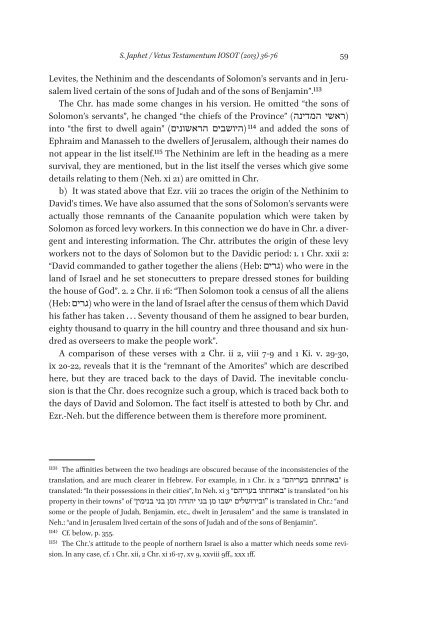Special Issue IOSOT 2013 - Books and Journals
Special Issue IOSOT 2013 - Books and Journals
Special Issue IOSOT 2013 - Books and Journals
Create successful ePaper yourself
Turn your PDF publications into a flip-book with our unique Google optimized e-Paper software.
S. Japhet / Vetus Testamentum <strong>IOSOT</strong> (<strong>2013</strong>) 36-76 59<br />
Levites, the Nethinim <strong>and</strong> the descendants of Solomon’s servants <strong>and</strong> in Jerusalem<br />
lived certain of the sons of Judah <strong>and</strong> of the sons of Benjamin”.113<br />
The Chr. has made some changes in his version. He omitted “the sons of<br />
(ראשי המדינה) Province” Solomon’s servants”, he changed “the chiefs of the<br />
into “the first to dwell again” )היושבים הראשונים) 114 <strong>and</strong> added the sons of<br />
Ephraim <strong>and</strong> Manasseh to the dwellers of Jerusalem, although their names do<br />
not appear in the list itself.115 The Nethinim are left in the heading as a mere<br />
survival, they are mentioned, but in the list itself the verses which give some<br />
details relating to them (Neh. xi 21) are omitted in Chr.<br />
b) It was stated above that Ezr. viii 20 traces the origin of the Nethinim to<br />
David’s times. We have also assumed that the sons of Solomon’s servants were<br />
actually those remnants of the Canaanite population which were taken by<br />
Solomon as forced levy workers. In this connection we do have in Chr. a divergent<br />
<strong>and</strong> interesting information. The Chr. attributes the origin of these levy<br />
workers not to the days of Solomon but to the Davidic period: 1. 1 Chr. xxii 2:<br />
“David comm<strong>and</strong>ed to gather together the aliens (Heb: (גרים who were in the<br />
l<strong>and</strong> of Israel <strong>and</strong> he set stonecutters to prepare dressed stones for building<br />
the house of God”. 2. 2 Chr. ii 16: “Then Solomon took a census of all the aliens<br />
(Heb: (גרים who were in the l<strong>and</strong> of Israel after the census of them which David<br />
his father has taken . . . Seventy thous<strong>and</strong> of them he assigned to bear burden,<br />
eighty thous<strong>and</strong> to quarry in the hill country <strong>and</strong> three thous<strong>and</strong> <strong>and</strong> six hundred<br />
as overseers to make the people work”.<br />
A comparison of these verses with 2 Chr. ii 2, viii 7-9 <strong>and</strong> 1 Ki. v. 29-30,<br />
ix 20-22, reveals that it is the “remnant of the Amorites” which are described<br />
here, but they are traced back to the days of David. The inevitable conclusion<br />
is that the Chr. does recognize such a group, which is traced back both to<br />
the days of David <strong>and</strong> Solomon. The fact itself is attested to both by Chr. <strong>and</strong><br />
Ezr.-Neh. but the difference between them is therefore more prominent.<br />
113) The affinities between the two headings are obscured because of the inconsistencies of the<br />
translation, <strong>and</strong> are much clearer in Hebrew. For example, in 1 Chr. ix 2 בעריהם“ ”באחוזתם is<br />
translated: “In their possessions in their cities”, In Neh. xi 3 בעריהם“ ”באחוזתו is translated “on his<br />
property in their towns” of ישבו מן בני יהודה ומן בני בנימין“ “ובירושלים is translated in Chr.: “<strong>and</strong><br />
some or the people of Judah, Benjamin, etc., dwelt in Jerusalem” <strong>and</strong> the same is translated in<br />
Neh.: “<strong>and</strong> in Jerusalem lived certain of the sons of Judah <strong>and</strong> of the sons of Benjamin”.<br />
114) Cf. below, p. 355.<br />
115) The Chr.’s attitude to the people of northern Israel is also a matter which needs some revision.<br />
In any case, cf. 1 Chr. xii, 2 Chr. xi 16-17, xv 9, xxviii 9ff., xxx 1ff.








![Am HaSefer [Volk des Buches] - Books and Journals](https://img.yumpu.com/20648352/1/174x260/am-hasefer-volk-des-buches-books-and-journals.jpg?quality=85)







